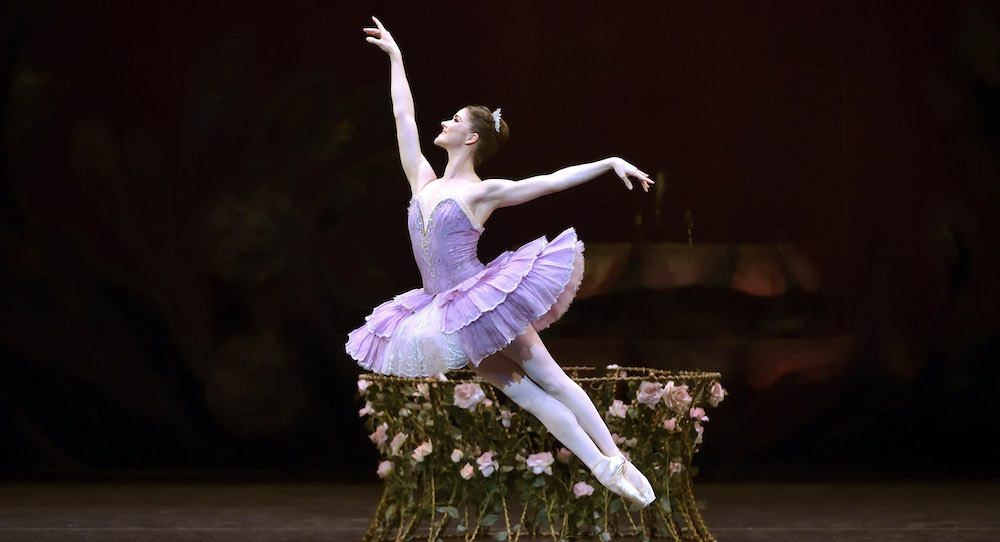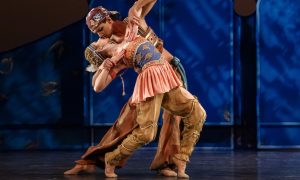Cassandra Trenary is one of those exceptional talents who motivates the world on multiple levels. Stunning, grounded and grateful, she was recently promoted to Principal Dancer with American Ballet Theatre (ABT) — a lifelong dream realized in a dark and confusing time. The shockwaves of such news rippled through many levels of emotions underpinned by deep gratitude for her art form and all the people who supported her along the way.
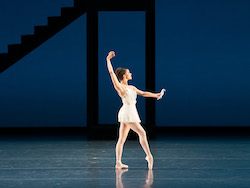
© The George Balanchine Trust.
Photo by Kyle Froman.
Join Dance Informa as we talk to Trenary about her promotion, key milestones, life in isolation and those who have inspired her to get to where she is today.
As everyone knows, 2020 has been a challenging year for all — it goes without saying. But for the dance world in particular, when you have dedicated the majority of your life to refining your art form and then being faced with incredible uncertainty, it can be incredibly confusing and daunting. When Trenary received the news about her promotion, she describes the moment vividly. “I was completely shocked and overwhelmed with emotion. It was as if the floodgates had opened, and everything I had taken on, or bottled up this year, just came out. The dream of what the fantasy ‘American Ballet Theatre’ career could look like had come to a halt, and didn’t seem so important with everything that has been happening in our country, and across the globe.”
Trenary continues, “I had decided to take this moment to broaden my horizons. But when Kevin McKenzie [ABT artistic director] called me that night to share this news, I couldn’t believe it — that this lifelong dream could be realized in such a challenging moment. All I felt, and continue to feel, is deep gratitude, relief and even joy.”
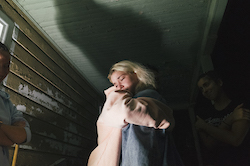
her ABT promotion.
Photo by Simon Benjamin.
She has thought about this day for many years. “When I was 13 years old, I had to write an essay each year as an ABT National Training Scholar for the summer intensives. I would always write under ‘What are your goals? something like, ‘I want to be a Principal Dancer with American Ballet Theatre.’ As I got older, the essays became a little more realistic. I would write something more like, ‘I’d love to dance in a professional ballet company.’ I had dreamt of this since I went to my first summer intensive at the age of 12.”
Reflecting back, Trenary adds, “It became more and more attainable as I rose through the ranks and had been offered quite a few principal roles as my career had gone on, but there has always been a side of me that has wanted to protect myself. I have been hesitant to dwell on the promotion to principal for fear of disappointment. I had risen to soloist quite fast, and that had never been lost on me. With that in mind, I had shifted my dreams toward being the best I could be and take full advantage of every opportunity offered to me.”
Openly, she notes, “That goes for in the studio and out. Every project, every season of exploration, informed my work when I would be back in ‘ABT mode’, and it has provided me with an extensive vocabulary.” This enabled Trenary to become more versatile and “find an identity as an artist within the ballet world,” she says.
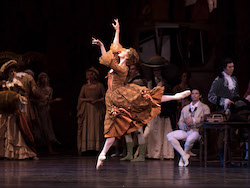
Lescaut’s Mistress in ‘Manon’.
Photo by Rosalie O’Connor.
Within the current climate of 2020, she explains, “What is interesting about this COVID-19 promotion — and the reason this was so shocking — is because for as long as I have been in ABT, promotions had happened the same way. They would always take place in the same studio at the Metropolitan Opera House, the last week of our spring season, with all of the staff and your colleagues around you. I never could have predicted how it was announced to me. I have thought about it for a long time.”
From a young age, Trenary was captivated by the art form, and her eyes were opened to many possibilities when she was exposed to elite levels. “I went to my first summer intensive, which happened to be ABT Alabama, at the age of 12, and that is when I had been introduced to the ballet world on an elite level,” she notes. “Until that moment, I honestly didn’t think it was an attainable profession. It seemed so far away. Although I had great training and encouragement from my teachers at home, going to ABT’s Summer Intensive, having the introduction to the ballet world like that, had drawn me in.”
Continuing to reflect, she says, “I think it was just the first time I had been recognized as special, as a young person. In a sea of great, young, aspiring ballerinas, I was told that I had something. I was lucky to be nurtured, and I just loved to dance! It was also the first time I was exposed to ballets such as Romeo and Juliet, Giselle and Swan Lake. I was drawn to them — the music, the storytelling. It pulls you in and speaks to the soul in the way sometimes only ballet can.”
Remembering an ABT souvenir book her aunt purchased for her after that first intensive, she remembers former ABT Principal Stella Abrera being on the cover and recalls, “I just remember looking through the book, and wanting so desperately to be in there with those ballerinas.”
Following this memory, she retells, “After that first summer intensive, I was offered the opportunity to go to New York on scholarship, then offered a place in the Jacqueline Kennedy Onassis (JKO) School, then before I knew it, I was in the company. It was a lot of hard work, but still, it feels like ballet chose me, although not without its challenges. The journey to becoming a ballerina felt like an organic path in my life from that age of 12.”
Looking back at key decisions, milestones and events, which led her to this day, are too many to recount. However, recalling those monumental moments, Trenary particularly notes the decision to go to JKO as the first major turning point. “My parents and brother made a huge sacrifice to move altogether to New York to ensure that I could pursue my passion with their support right there with me.” Having sold their house and belongings in Georgia, they set off.
Upon joining ABT, after many great opportunities to be featured very quickly, she found herself getting injured a lot. “There was a period when I felt as though I wasn’t going to continue to receive opportunities while my body was unreliable,” she admits. During a particularly long injury (followed by another), she explains, “I became rather discouraged that my dreams of rising up in this company were probably not on the cards anymore.”
Placing a positive spin on darker times, she adopted new skills. “I decided to audition for a play. I got the role and took up this theater project, and was even offered a leading role in a television series. This was a major moment for me because I found myself at a crossroads.”
Ultimately, she decided she would invest her time in healing and by continuing her dance journey, but by this stage, she had some great acting experience under her belt. “I learned a whole lot about a world that I knew I’d want to inhabit one day,” she notes with a new perspective.
Before long, the following year, she was promoted to Soloist. Looking back, she realizes, “In many ways, I believe that little bit of acting experience informed my dancing. It was a necessary time, even if it came with some heartbreak and being pushed out of my comfort zone.”
During Trenary’s first year as Soloist, she was offered the opportunity to dance Aurora in Alexei Ratmansky’s The Sleeping Beauty. Excited by the opportunity, she now reflects, “Dancing any soloist role was a dream come true. Being cast as Aurora was a terrifying and exhilarating endeavor. This was a moment of so much growth for me, and was the first time I had experienced so much personalized coaching.”
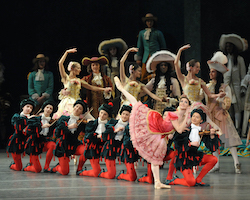
in ‘The Sleeping Beauty’.
Photo by John Grigaitis.
She continues gratefully, “I attribute so much artistic growth to my time working with Arthur Pita on The Tenant a couple of years back. It was an incredible experience to create a character, workshop, research and create as a group and tell a very compelling and challenging story based on a novel by Roland Topor. Arthur created a safe environment to explore dark themes that allowed me to push myself a little further as an actress.”
From dark themes to dark times, her debut as Juliet in Romeo and Juliet was delayed due to the pandemic, and the lead-up to performing this role was not taken lightly. “This has been the role of my dreams since the moment I joined ABT,” Trenary shares. “When I received the Annenberg Fellowship in 2017, I used a portion of the funds to go to The Royal Ballet and receive coaching from Viviana Durante on the role. It was a joy to work on, even if it was just for me. To have the opportunity to dance this ballet, and to debut it with a great friend and artist, Calvin Royal III, was too much wonderful to handle.”
Imagining how she would approach the role for so many years, as a dancer who likes to do research, she immediately set off on a journey to learn everything she could behind Sir Kenneth MacMillan’s approach to telling this story. Trenary notes, “I knew I wanted to go back to The Royal Ballet to gather more information, especially being the house in which the ballet was conceived. I had started learning the choreography from Kevin [McKenzie], and then requested to go on a trip to London last fall. He suggested I contact Lynn Seymour, the ballerina whom MacMillan created Juliet on, and learn from her every detail that I could. So I did!”
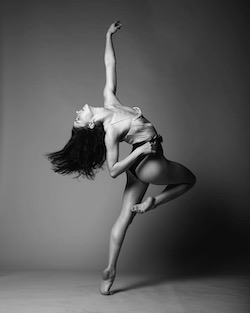
With the generosity of Kevin O’Hare, director of The Royal Ballet, she took class with the company. “I even got to work with Leanne Benjamin, and then I would spend most days with Lynn at her home, and in a studio,” says Trenary. “We would watch a recording of the ballet together, and she would talk about every single moment and even get up and demonstrate parts right in her living space. It was remarkable. Other days, we just ended up going on walks and sharing stories. The trip feels like a distant dream now. Calvin and I worked very hard and invested everything we could into becoming these characters. We were extremely excited to share this with the world, and it was painful to lose this special moment.”
Optimistically, with an undertone of sadness, she notes, “We know it’s a postponement, but it seems like it will be a long one. There has just been a lot of grief. But everything we experience in this time will be more information to use as fuel when we do get the moment. It may just be a few years.”
Mental stamina has been challenging during 2020, and the way Trenary works through it is by “trying to be as present as possible. The minute I start thinking too far ahead is when I find myself spiraling a little bit. For someone who is used to knowing their schedule sometimes two years in advance, this is hard. When I just take it minute-by-minute, my anxiety goes way down. I’ve tried to think about what I’d really love to do each day, and meet myself wherever I am.”
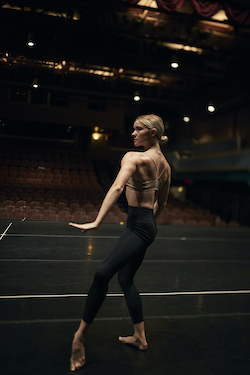
‘State of Darkness’.
Photo by Mohamad Sadek.
Although everyone was in isolation, the dance world came together in a powerful way to stay connected, to continue expressing, and to keep the art form alive and evolving. Collaborations such as the film Shelter and Trenary’s solo in Molissa Fenley’s 1988 work State of Darkness (presented by The Joyce Theater to a virtual audience) were both incredibly intriguing projects to be a part of, not to mention the process. She explains, “Everyone kind of went into action mode. Shelter was nice as a way of expressing how we were feeling as artists right as the pandemic had become a very real reality for us. I am a huge fan of Danielle Rowe and Garen Scribner, whose choreography was used in the film, so when they asked me to be a part of it, I was thrilled. It was nice to have something to work on, a goal to work toward, and I thought the result was really moving.”
Other projects, too, presented great opportunities, including State of Darkness. Trenary says, “I have experienced more change these last months than most do in several years. I love how Fenley’s solo reflects that test of endurance. It wasn’t created this year! I was contacted by Ross LeClair of The Joyce, asking if I’d be interested in learning and performing this piece. When he sent me a video of the work (the show at The Joyce in 1990), I was struck by the relentlessness of it. I felt like I had been seen by this work.”
Adding on, she says, “Obviously, having the chance of performing live on a stage sounded way too good to be true, and I said yes! Then to see the list of dancers who also said yes, I was so grateful to be included in the group. We all began the process by Zooming in for three hours a day with Molissa and her rehearsal director, Rebecca Chaleff, teaching us the 35-minute piece, in increments. We were all in our apartments, homes and studio space, if we could safely find it.” Becoming the norm, it became the way dancers learned new work, and slowly they each had the chance to enter into the theater and have socially distant rehearsals with Fenley in person.
Gratefully, she expresses, “The process has been beyond rewarding. I have connected with an astounding group of artists who each approach this art form in such unique ways, and it has been an absolute joy to learn from each of them throughout this process.”
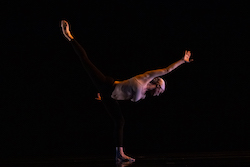
‘State of Darkness’.
Photo by Art Davison.
These haven’t been the only projects Trenary has been involved in. Keeping motivation levels high, she shares, “I have been fortunate enough to be involved in quite a few projects which started in July. I remotely collaborated with Kat Sullivan, a tech visual artist, to create a short film. It will be released as a part of a digital series ABT has produced with Little Monster Films. Cirio Collective quarantined and gathered together to create and film new work choreographed by Jeff Cirio.”
In addition, she notes, “I workshopped some new work with Sonya Tayeh. Then I performed in the Kaatsbaan Summer Festival, followed by a residency there with CoLab Dance. Lauren Post, ABT dancer and CoLab artistic director, commissioned me to choreograph a short film which we were able to create on the Kaatsbaan property over our two-week residency.”
If that wasn’t enough to keep this talent busy, she includes, “I have had the privilege of being invited by the Guggenheim’s Works & Process to create a film for their virtual series, so that will be next.”
Being surrounded by fellow artists, both passionate and diverse in approach to the art form, led to many insightful conversations with observations during these projects. Trenary shares, “There have been so many good conversations. As scary and sad as this time has been, it has also been an opportunity for growth. I cannot speak for the collective, but I can say that I have recognized that I have a lot more to offer than what I have given myself credit for. I can take more liberties. All dancers have more to offer — we are activists, authors, producers, business owners — why not run for office?”
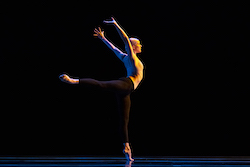
Photo by Art Davison.
Recognizing that this has been a time of growth and empowerment, she admits, “We can do so much more. I have done my best to encourage my fellow artists to feel this way, as they have encouraged me. It has also just been a great time to connect on a human level and learn how I can be of better service to others — in the arts and community.”
It’s easy to get caught up in getting to the top in one’s field, but acknowledging this shows Trenary’s true character. “This is not the priority right now. We are all going through some crazy stuff, and I want to do my best to lift up those who are struggling most in my life. I have certainly been lifted up by my friends, colleagues and fellow artists time and time again.”
With a new appreciation on life, and deep gratitude toward her art form, the road ahead is still not entirely clear. She notes honestly, “There is too much going on right now to really know the road ahead. I know I miss it with all of my heart. I know that every time I do get to dance or create, it feels like the most precious gift in the world. I am grateful for all of the personal growth I have experienced during this time, and I know that the information I have gathered as an artist and human in this moment will trickle over into everything I pursue in the future as a principal dancer. I want to enter spaces and shift the culture for the better.”
By Renata Ogayar of Dance Informa.


